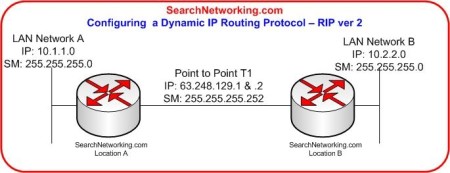|
Note that this article was originally published at SearchNetworking.com. In our last article, we talked about the importance of static IP routing. Static routing still has an important place, but as a network administrator, you must also know dynamic IP routing like the back of your hand. In this article, we’ll explore dynamic IP routing and you’ll learn the practical information that you need to know about it. Checkout this Video series on the Cisco CCNA Certification!
|
Cisco IOS IP routing — dynamic routing
By David M Davis
Routing in generalTo review from the last tip, the router learns the next hop for packets using one of two methods:
Checkout this Video series on the Cisco CCNA Certification!
Static routing issuesWith static routing, you are telling your router to send traffic with a destination IP address to a router with an IP address of x.x.x.x. This is handy for a small network with very few routes or for someone who wants to have absolute control, but it can become very cumbersome as your network grows. To keep a multi-site wide-area network fully connected (fully meshed) via static routes, you have to create a route on every router for every other router. This mean that, as you add more sites, the number of routes you have to create increases exponentially, and when sites go down or links are performing poorly, any corrections must be entered manually. Checkout this Video series on the Cisco CCNA Certification!
Benefits of dynamic routingA dynamic routing protocol can resolve these issues for you. Here are some general benefits of using a dynamic routing protocol:
Checkout this Video series on the Cisco CCNA Certification!
Gotchas of dynamic routingDon’t think that dynamic routing protocols are perfect, however. Here are some possible gotchas of using dynamic routing protocols:
Dynamic routing protocolsYou may be wishing you had some examples of dynamic routing protocols. I’m not going to cover or compare all possible routing protocols, but let’s talk about the dynamic routing protocols you need to know. First off, there are the interior gateway routing protocols (IGP). These are protocols that you would use within your own network. They are the protocols that are supported by just about every router and server operating system (such as Windows 2003 Server and Linux):
And, in a class by itself, there is Border Gateway Protocol (BGP):
Configuring dynamic routingSo all this theoretical stuff is great, right? It gives you a good foundation, but you probably want to see how to configure a dynamic routing protocol. Let’s say that we have the basic network, shown below:
Checkout this Video series on the Cisco CCNA Certification!
It is our job to configure RIP between these two locations so that each network knows about the other router’s networks. Assuming that all normal router IP addressing is configured and interfaces have been enabled, we need issue only a few simple commands on each router to accomplish this. Here is the configuration: Location A Location B What this does is: · Enter routing configuration mode on each router. · Enable Version 2 of the RIP routing protocol. · Enable RIP routing on both the LAN and the WAN networks. This will tell the router both to advertise these networks to other routers and to try and find other routers on these networks. Once completed, here is the routing table and ping output for Location A: Location-A# show ip route Codes: C - connected, S - static, R - RIP, M - mobile, B - BGP D - EIGRP, EX - EIGRP external, O - OSPF, IA - OSPF inter area N1 - OSPF NSSA external type 1, N2 - OSPF NSSA external type 2 E1 - OSPF external type 1, E2 - OSPF external type 2 i - IS-IS, su - IS-IS summary, L1 - IS-IS level-1, L2 - IS-IS level-2 ia - IS-IS inter area, * - candidate default, U - per-user static route o - ODR, P - periodic downloaded static route Gateway of last resort is not set 10.0.0.0/24 is subnetted, 2 subnets R 10.2.2.0 [120/1] via 63.248.129.2, 00:00:16, Serial0 C 10.1.1.0 is directly connected, Ethernet0 63.0.0.0/30 is subnetted, 1 subnets C 63.248.129.0 is directly connected, Serial0 Location-A# ping 10.2.2.1 Type escape sequence to abort. Sending 5, 100-byte ICMP Echos to 10.2.2.1, timeout is 2 seconds: !!!!! Success rate is 100 percent (5/5), round-trip min/avg/max = 32/35/36 ms Location-A# And here is Location B's routing table: Location-B# show ip route Codes: C - connected, S - static, I - IGRP, R - RIP, M - mobile, B - BGP D - EIGRP, EX - EIGRP external, O - OSPF, IA - OSPF inter area E1 - OSPF external type 1, E2 - OSPF external type 2, E - EGP i - IS-IS, L1 - IS-IS level-1, L2 - IS-IS level-2, * - candidate default U - per-user static route Gateway of last resort is not set 10.0.0.0/8 is subnetted, 2 subnets R 10.1.1.0 [120/1] via 63.248.129.1, 00:00:00, Serial0 C 10.2.2.0 is directly connected, Ethernet0 63.0.0.0/8 is subnetted, 1 subnets C 63.248.129.0 is directly connected, Serial0 Location-B# ping 10.1.1.1 Type escape sequence to abort. Sending 5, 100-byte ICMP Echoes to 10.1.1.1, timeout is 2 seconds: !!!!! Success rate is 100 percent (5/5), round-trip min/avg/max = 32/35/36 ms Location-B# As you can see, each router knows about the other router’s LAN networks t We could have accomplished the same connectivity with only one static route on each router. However, as this network grows from two routers to 20 or 200, the time needed to administer static routing would be a horrible administrative burden. Checkout this Video series on the Cisco CCNA Certification!
SummaryIn summary, as a network administrator, you should have some basic knowledge of the four most popular dynamic routing protocols in use today. If you are new at this, I recommend that you start by learning about RIP and move up to the other protocols from there. |



 David Davis (CCIE #9369, VCP, CISSP, MCSE) has been in the IT industry for 15+ years. He has authored over 300 articles, 6 video training courses, and co-authored one book. Learn about David's certifications, video courses, and where you can find his content on our
David Davis (CCIE #9369, VCP, CISSP, MCSE) has been in the IT industry for 15+ years. He has authored over 300 articles, 6 video training courses, and co-authored one book. Learn about David's certifications, video courses, and where you can find his content on our
{ 0 comments… add one now }